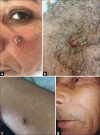Inverted Follicular Keratosis: A Retrospective Study Over 10 Years
- PMID: 37151274
- PMCID: PMC10162730
- DOI: 10.4103/ijd.ijd_968_21
Inverted Follicular Keratosis: A Retrospective Study Over 10 Years
Abstract
Inverted follicular keratosis (IFK) is a rare benign tumour of the follicular infundibulum characterized by exo-endophytic growing. Generally, the diagnosis of IFK is histopathologically made because clinical differentiation from other lesions is difficult. We present a retrospective series with thirteen patients with histologically confirmed IFK to evaluate the epidemiological, clinical and histopathologic characteristics of IFK. The mean age of the patients at the time of the excision was 53 years with extremes ranging from 19 to 82 years. The sex ratio M/F was 3.3. The lesions affected the face in nine patients mainly the moustache, followed by the scalp in three cases and the arm in one case, and 92% of the localizations are sun-exposed. The diagnosis was never clinically evoked. The lesion had a pink colour in ten cases and was pigmented in two cases and hypopigmented in one case. More than half of the lesions (53%) had a keratotic centre. Histopathological examination showed endophytic intradermal proliferation of basaloid cells with a variable degree of squamoid differentiation. Horn cysts were present in all cases. According to our series, the IFK occurs predominantly in young men, in the face and more specifically in the moustache. Dermoscopy may suggest the diagnosis of the IFK. In fact, a histopathological examination is the gold standard for the diagnosis of the IFK and helps differentiate these benign tumours from possible malignant neoplasms.
Keywords: Benign tumours; inverted follicular keratosis; pathology.
Copyright: © 2023 Indian Journal of Dermatology.
Conflict of interest statement
There are no conflicts of interest.
Figures



References
-
- Kenney M, Lester EB, Cook DL. Inverted follicular keratoses of the buttocks. J Cutan Pathol. 2018;45:369–70. - PubMed
-
- Díez-Montero C, González GD, Pérez ME, Schellini S, Galindo-Ferreiro A. Periocular inverted follicular keratosis: A retrospective series over 17 years. Jpn J Ophthalmol. 2019;63:210–4. - PubMed
-
- Shah R, Maddukuri S, Patel S, Behbahani S, Skula S, Lambert WC. Inverted follicular keratosis: Stand-alone entity or variant. Skinmed. 2019;17:93–4. - PubMed
-
- Battistella M, Peltre B, Cribier B. Composite tumors associating trichoblastoma and benign epidermal/follicular neoplasm: Another proof of the follicular nature of inverted follicular keratosis. J Cutan Pathol. 2010;37:1057–63. - PubMed
LinkOut - more resources
Full Text Sources
